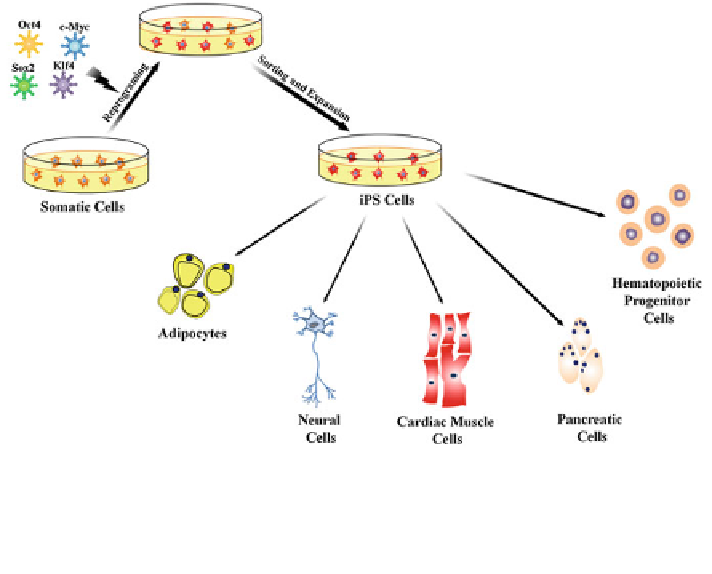Biomedical Engineering Reference
In-Depth Information
Fig. 2 Reprogramming somatic cells and the differentiation potential of iPS. iPS can be
originated by viral transduction of a set of four transcription factors, e.g., Oct4, c-Myc, Sox2 and
Klf4. These cells are pluripotent and have been successfully induced into endoderm, ectoderm
and mesoderm cell lineages, such as adipocytes, hepatocytes, neural cells, cardiac muscle cells,
pancreatic cells, and hematopoietic progenitors
giving rise to tumor formation on their own. Novel strategies use non-integrating
viral vectors such as adenoviral or AAV-derived vectors to reduce the risk of
insertion mutagenesis and subsequent cancer development, but these techniques
diminish the already limited reprogramming efficiency [
35
,
37
].
The obtained iPS display most characteristics of ESCs and can hardly be dis-
tinguished from them with respect to morphology, proliferation, gene expression,
differentiation potential or surface antigens. However, differences can be found in
the epigenetic status of the cells. Although the epigenetic status of iPS is very
similar to that of ESCs, the iPS seem to keep at least part of the epigenetic features
of the original cell [
38
]. In addition, recent data unexpectedly hint at rejection
events after transplantation into inbred mouse strains [
39
]. If this report can be
supported with further data, especially using cells differentiated from iPS, a major
advantage of these cells--the use of autologous material with the potential of
ESCs--is jeopardized.
The high risk of teratoma formation or simply the novelty of the cells might be
the reason why relatively few data exist on the use of iPS for hard tissues.
Nevertheless they also seem to have advantages when compared to adult SCs
approaches, although iPS need rather a long time (12 weeks) to differentiate
towards osteoblasts. When seeded in a gelfoam matrix and investigated in
vitro and after transplantation in mice also in vivo, the authors report, as well
as the expected data on osteodifferentiation, the recruitment of vasculature and

Search WWH ::

Custom Search